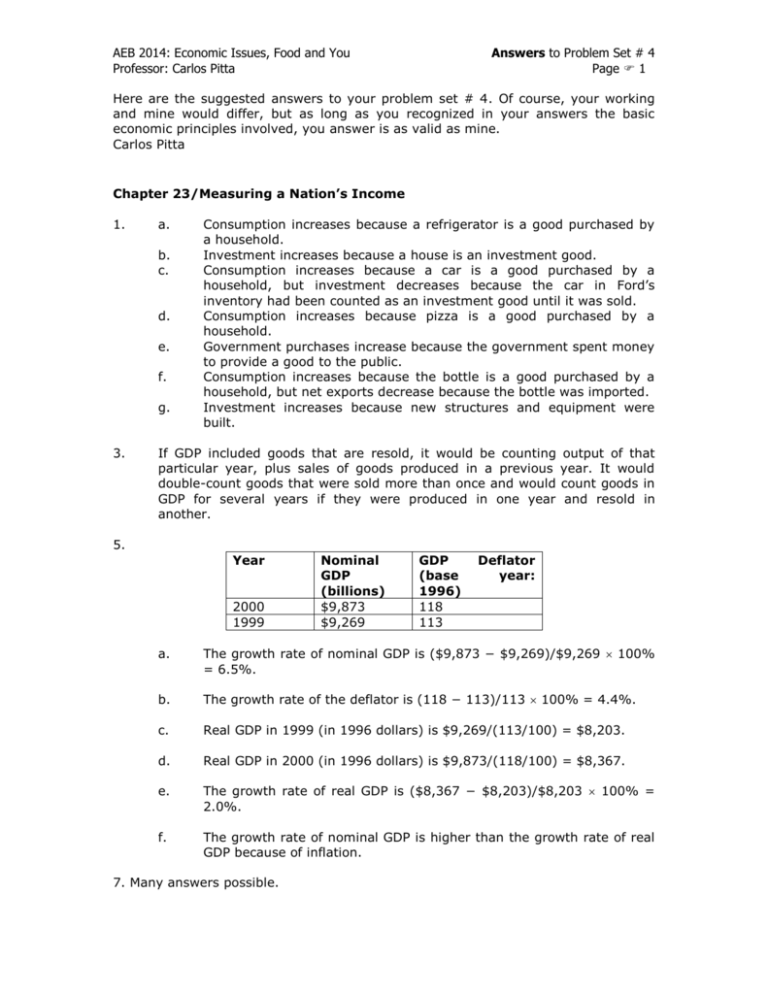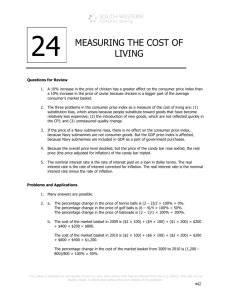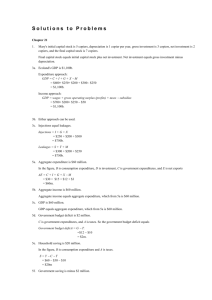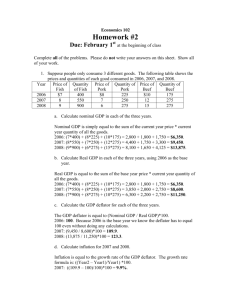Answers to PS # 4
advertisement

AEB 2014: Economic Issues, Food and You Professor: Carlos Pitta Answers to Problem Set # 4 Page 1 Here are the suggested answers to your problem set # 4. Of course, your working and mine would differ, but as long as you recognized in your answers the basic economic principles involved, you answer is as valid as mine. Carlos Pitta Chapter 23/Measuring a Nation’s Income 1. a. b. c. d. e. f. g. 3. Consumption increases because a refrigerator is a good purchased by a household. Investment increases because a house is an investment good. Consumption increases because a car is a good purchased by a household, but investment decreases because the car in Ford’s inventory had been counted as an investment good until it was sold. Consumption increases because pizza is a good purchased by a household. Government purchases increase because the government spent money to provide a good to the public. Consumption increases because the bottle is a good purchased by a household, but net exports decrease because the bottle was imported. Investment increases because new structures and equipment were built. If GDP included goods that are resold, it would be counting particular year, plus sales of goods produced in a previous double-count goods that were sold more than once and would GDP for several years if they were produced in one year another. output of that year. It would count goods in and resold in 5. Year 2000 1999 Nominal GDP (billions) $9,873 $9,269 GDP (base 1996) 118 113 Deflator year: a. The growth rate of nominal GDP is ($9,873 − $9,269)/$9,269 100% = 6.5%. b. The growth rate of the deflator is (118 − 113)/113 100% = 4.4%. c. Real GDP in 1999 (in 1996 dollars) is $9,269/(113/100) = $8,203. d. Real GDP in 2000 (in 1996 dollars) is $9,873/(118/100) = $8,367. e. The growth rate of real GDP is ($8,367 − $8,203)/$8,203 100% = 2.0%. f. The growth rate of nominal GDP is higher than the growth rate of real GDP because of inflation. 7. Many answers possible. AEB 2014: Economic Issues, Food and You Professor: Carlos Pitta 9. 11. Answers to Problem Set # 4 Page 2 a. GDP is the market value of the final good sold, $180. b. Value added for the farmer: $100. Value added for the miller: $150 – $100 = $50. Value added for the baker: $180 – $150 = $30. c. Together, the value added for the three producers is $100 + $50 + $30 = $180. This is the value of GDP. If the government cares about the total income of Americans, it will emphasize GNP, because that measure includes the incomes of Americans that is earned abroad and excludes the incomes of foreigners living in the United States. If the government cares about the total amount of economic activity occurring in the United States, it will emphasize GDP, which measures the level of production in the country, whether produced by domestic citizens or foreigners. Chapter 24/ Measuring the Cost of Living 1. a. Find the price of each good in each year: Year 2006 2007 b. Cauliflower $2 $3 Broccoli $1.50 $1.50 Carrots $0.10 $0.20 If 2006 is the base year, the market basket used to compute the CPI is 100 heads of cauliflower, 50 bunches of broccoli, and 500 carrots. We must now calculate the cost of the market basket in each year: 2006: (100 x $2) + (50 x $1.50) + (500 x $.10) = $325 2007: (100 x $3) + (50 x $1.50) + (500 x $.20) = $475 Then, using 2006 as the base year, we can compute the CPI in each year: 2006: $325/$325 x 100 = 100 2007: $475/$325 x 100 = 146 3. c. We can use the CPI to compute the inflation rate for 2007: (146 − 100)/100 x 100% = 46% a. The percentage change in the price of tennis balls is (2 – 2)/2 × 100% = 0%. The percentage change in the price of golf balls is (6 – 4)/4 × 100% = 50%. The percentage change in the price of Gatorade is (2 – 1)/1 × 100% = 100%. b. The cost of the market basket in 2006 is ($2 × 100) + ($4 × 100) + ($1 × 200) = $200 + $400 + $200 = $800. AEB 2014: Economic Issues, Food and You Professor: Carlos Pitta Answers to Problem Set # 4 Page 3 The cost of the market basket in 2007 is ($2 × 100) + ($6 × 100) + ($2 × 200) = $200 + $600 + $400 = $1,200. The percentage change in the cost of the market basket from 2006 to 2007 is (1,200 – 800)/800 × 100% = 50%. 5. c. This would lower my estimation of the inflation rate because the value of a bottle of Gatorade is now greater than before. The comparison should be made on a per-ounce basis. d. More flavors enhance consumers’ well-being. Thus, this would be considered a change in quality and would also lower my estimate of the inflation rate. a. introduction of new goods; b. unmeasured quality change; c. substitution bias; d. unmeasured quality change; e. substitution bias 7. 9. a. If the elderly consume the same market basket as other people, Social Security would provide the elderly with an improvement in their standard of living each year because the CPI overstates inflation and Social Security payments are tied to the CPI. b. Because the elderly consume more health care than younger people do, and because health care costs have risen faster than overall inflation, it is possible that the elderly are worse off. To investigate this, you would need to put together a market basket for the elderly, which would have a higher weight on health care. You would then compare the rise in the cost of the "elderly" basket with that of the general basket for CPI. In deciding how much income to save for retirement, workers should consider the real interest rate, because they care about their purchasing power in the future, not the number of dollars they will have. AEB 2014: Economic Issues, Food and You Professor: Carlos Pitta Answers to Problem Set # 4 Page 4 Chapter 25/ Production and Growth 1. The facts that countries import many goods and services yet must produce a large quantity of goods and services themselves to enjoy a high standard of living are reconciled by noting that there are substantial gains from trade. In order to be able to afford to purchase goods from other countries, an economy must generate income. By producing many goods and services, then trading them for goods and services produced in other countries, a nation maximizes its standard of living. 3. a. Private consumption spending includes buying food and buying clothes; private investment spending includes people buying houses and firms buying computers. Many other examples are possible. Education can be considered as both consumption and investment. b. Government consumption spending includes paying workers to administer government programs; government investment spending includes buying military equipment and building roads. Many other examples are possible. Government spending on health programs is an investment in human capital. This is truer for spending on health programs for the young rather than those for the elderly. a. When a German firm opens a factory in South Carolina, it represents foreign direct investment. b. The investment increases U.S. GDP because it increases production in the United States. The effect on U.S. GNP would be smaller because the owners would get paid a return on their investment that would be part of German GNP rather than U.S. GNP. 5. 7. Greater educational opportunities for women could lead to faster economic growth in the countries of South Asia because increased human capital would increase productivity and there would be external effects from greater knowledge in the country. Second, increased educational opportunities for young women may lower the population growth rate because such opportunities raise the opportunity cost of having a child. 9. a. Political stability could lead to strong economic growth by making the country attractive to investors. The increased investment would raise economic growth. b. Strong economic growth could lead to political stability because when people have high incomes they tend to be satisfied with the political system and are less likely to overthrow or change the government.













